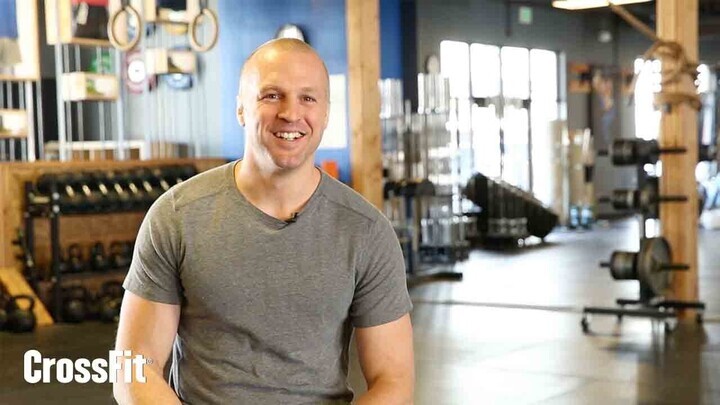Question: Should the athletes’ heels leave the ground on the push press?
This is a question I frequently receive at the CrossFit Level 1 and Level 2 Certificate Courses, and I occasionally receive it in my day-to-day training. This question is usually derived from our initial instruction, which typically involves a teaching progression with the heels remaining in contact with the floor.
We have found if we prematurely instruct lifting the heels on the drive phase of the movement, it can pull the athlete forward when timed incorrectly. This issue can lead to instability and a bar path deviating forward from the frontal plane. What we expect is that the athlete focuses on accelerating aggressively through the full foot, then, once full hip and knee extension has been achieved, they lift and return to the floor quickly and naturally as a byproduct of the fast hip and knee extension.
So, is it incorrect if an athlete’s heels leave the floor? The answer is “maybe.” Here’s what to look for.
Incorrect – Shifting Forward on the Dip
If you notice an athlete’s heels lifting or an excessive shift toward the toes during the “dip” phase of the movement, the athlete needs to be cued to stay back on their heels or to potentially shorten the depth of their dip.
Incorrect – Heels Lift Before the Legs and Hips Extend
If you notice in the drive phase that an athlete’s heels are elevating before their knees and hips have extended, you can cue the athlete to keep their heels down. This premature heel lift is a *core-to-extremity violation and will hinder power output and force potential because the glutes, hamstrings, and quadriceps are not being utilized most effectively. As a byproduct of this fault, you may notice the bar travels forward of the frontal plane, and there may be instability in the overhead position.
Correct – Heels Lift After the Legs and Hips Extend
It is acceptable to lift the heels once the hips and knees have extended. This means the athlete is still utilizing their legs effectively. This does not typically need to be taught and will occur naturally as a “follow through” of the movement if an athlete aggressively extends the hips and knees, similar to a baseball pitcher’s arm “following through” after releasing the ball.
I’m aware of other coaches — specifically in Olympic weightlifting — who may directly instruct athletes to lift their heels, and that’s totally fine, as long as the coach can assess whether or not the heel lift is premature.
When working with our general clientele, teaching the heel lift tends to lead to faults, and I have moved away from it, knowing it will likely occur naturally.
Want to watch a Level 4 CrossFit coach teach the points of performance in the push press? You can find that here.
*Core-to-extremity movements demonstrate a sequence of muscular contraction that begins with the large force-producing, low-velocity muscles of the core (abdominals and spinal erectors) and hips and ends with the small force-producing, high-velocity muscles of the extremities (e.g., biceps, calves, wrist flexors).
Core-to-extremity movement begins with establishing midline stabilization for effective force transfer—i.e., a base is created, and force radiates from there. This muscular patterning teaches the athlete to fluidly transmit power from one area of the body to another. Core-to-extremity movement maximizes performance because it tasks the largest musculature to generate force first, allowing the greatest forces to develop. This sequence improves efficiency and allows the greatest amount of work to be accomplished.
Core-to-extremity movements are less risky than movements that violate this pattern because the largest muscles are tasked with generating the most force. Smaller muscle groups and associated tendons and ligaments are more susceptible to injury, such as tearing, when exposed to loading designed for larger movers.
Core-to-extremity movements are found everywhere, not just with movements that involve the arms and legs, so faults can show up everywhere. Even a shoulder press or a deadlift may not effectively demonstrate core-to-extremity movement absent a stable midline. For dynamic faults, core-to-extremity violations occur when there is incorrect timing and the arms move before the hips and legs have extended (i.e., pulling or pushing early).
Have a question for a coach? Please submit that here.
About the Author
 Eric O’Connor is a Content Developer and Seminar Staff Flowmaster for CrossFit’s Education Department and the co-creator of the former CrossFit Competitor’s Course. He has led over 400 seminars and has more than a decade of experience coaching at a CrossFit affiliate. He is a Certified CrossFit Coach (CF-L4), a former Division 1 collegiate wrestler, and a former CrossFit Games athlete.
Eric O’Connor is a Content Developer and Seminar Staff Flowmaster for CrossFit’s Education Department and the co-creator of the former CrossFit Competitor’s Course. He has led over 400 seminars and has more than a decade of experience coaching at a CrossFit affiliate. He is a Certified CrossFit Coach (CF-L4), a former Division 1 collegiate wrestler, and a former CrossFit Games athlete.
Ask a Coach: Should the Athletes' Heels Leave the Ground on the Push Press?